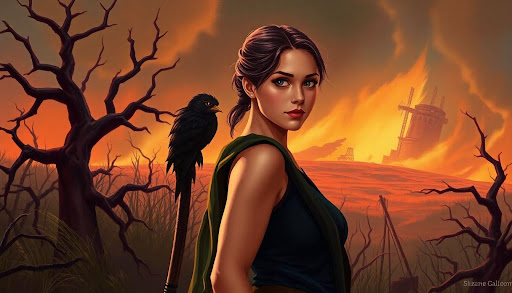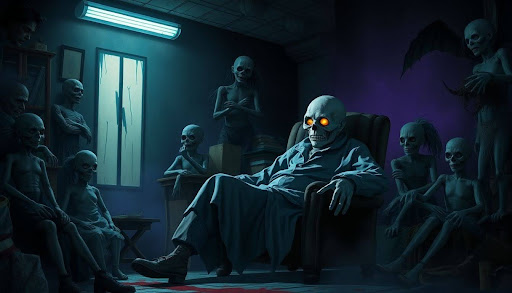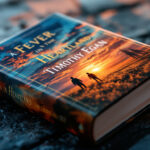Life and Death – Twilight Reimagined – Review for Fans & New Readers
Stephenie Meyer’s Life and Death: Twilight Reimagined flips the script on the beloved Twilight saga by giving us a fresh perspective with gender-swapped characters. Instead of Bella and Edward, we meet Beau and Edythe, leading readers on a familiar yet distinct journey through the same intriguing plot that fans know well.
This reimagining was released for the tenth anniversary of the original Twilight, aiming to address some of the gender dynamics that have sparked debate over the years. In this post, we’ll explore whether Meyer’s attempt to reshape familiar tropes succeeds or falls short. Whether you’re a longtime fan of the series or just curious about what makes this retelling special, there’s plenty to uncover in these pages. Prepare to find out how the new characters navigate love, danger, and heart-wrenching choices, all while echoing the iconic story you might already cherish.
Overview of ‘Life and Death: Twilight Reimagined’
Life and Death: Twilight Reimagined is an intriguing twist on Stephenie Meyer’s iconic Twilight series, offering a gender-swapped retelling that introduces readers to Beau Swan and Edythe Cullen. This novel essentially mirrors the original plot but flips the genders of beloved characters, providing a fresh lens through which to experience the familiar story. Beau, a 17-year-old male, relocates from sunny Phoenix, Arizona, to the moody town of Forks, Washington, where he crosses paths with the enigmatic vampire Edythe. Their relationship evolves amid the same love, danger, and supernatural elements that made Twilight so captivating. This reimagining not only revisits the themes and scenarios from the original but also aims to spark conversation around gender dynamics in storytelling.
What is ‘Life and Death’?
The essence of Life and Death revolves around the same plot that fans loved in Twilight, but with Beau and Edythe stepping into the shoes of Bella and Edward. As the story unfolds, Beau’s attraction to Edythe intertwines with her struggle to keep her vampire identity hidden. The book retains key elements, including iconic scenes, relationships, and conflicts, while also introducing some new characterizations and interactions that reflect the swapped genders. While some aspects remain unchanged, the subtle differences in character behavior and development offer an exploration of how gender influences narratives.
The Gender-Swapped Perspective
Flipping the genders of the main characters carries significant implications for the narrative. Beau embodies a different kind of agency compared to Bella, often showcasing self-reliance and decisiveness. This offers a contrast to Bella’s traditionally passive role, where she frequently needs saving. Readers witness Beau facing situations where he takes charge rather than playing the damsel. Edythe, in some ways, reflects traits that could be seen as more stereotypical in the original narrative but still aims to break away from those norms. The book prompts questions about masculinity and femininity. Are traditional gender roles upheld, or does the story offer a more balanced portrayal? The gender swap invites discussions on how character traits and motivations can shift perceptions without changing the core themes of love and longing at its heart.
Connection to the Original Twilight Series
Life and Death serves not only as a reimagining but also as a celebration of the tenth anniversary of Twilight. It maintains many plot points and structures of the original series, allowing readers to easily draw comparisons and identify parallels. This intentional nostalgia taps into the fond memories of the original while encouraging new insights. While some readers find the similarities too close for comfort, others appreciate the layers added by the gender swap. The book explores whether the themes of love, obsession, and the magic of first love resonate differently when viewed from another perspective. Overall, it highlights the enduring appeal of Meyer’s world while prompting reflection on how narratives can adapt and evolve over time.
Differences Between ‘Life and Death’ and ‘Twilight’
In Life and Death: Twilight Reimagined, Meyer presents not just a gender swap but a fresh take on the familiar narrative of Twilight. This section explores the notable differences that define Beau and Edythe’s story compared to Bella and Edward’s iconic tale.
Major Plot Changes
While Life and Death retains the core storyline of Twilight, several significant deviations in plot progression create a distinct experience for readers. Key moments, such as the prom and the revelation of Edythe’s true identity, are echoed, but they come with fresh twists. For instance, there’s a crucial scene where Beau is bitten by a vampire named Joss, an addition that introduces tension not found in the original.
Moreover, the conclusion diverges notably from Twilight. Instead of setting up for a sequel, this narrative acts as a standalone piece. It also attempts to challenge the traditional tropes by reframing circumstances that may have seemed problematic in the original.
Characterization of Beau and Edythe
Beau and Edythe bring new energy to the table with their unique personalities and dynamics. Beau exhibits traits that contrast sharply with Bella’s often passive demeanor. He displays more self-sufficiency and humor, offering readers a fresh perspective. His laid-back nature can be refreshing compared to Bella’s more serious approach to life’s dilemmas.
Edythe, on the other hand, presents a different set of challenges. While retaining the essence of Edward’s brooding charm, her character embodies a more proactive role, reflecting how gender influences relationships. The shifts in their interactions lead to fresh dialogues and scenarios, prompting readers to reconsider what attributes make a character relatable or admirable.
Readers might wonder how these changes affect the story’s overall themes. While the core elements of love and danger remain, the new dynamics open discussions on gender roles and character agency. Are Beau and Edythe merely reflections of their original counterparts, or do they ultimately pave the way for a new understanding of character agency?
A New Ending
The ending of Life and Death stands out with its unexpected twist, redefining the stakes for the characters involved. Instead of the usual seamless transition to a vampire life, Beau’s journey includes an intense moment of transformation after being bitten. This sharp turn creates a gripping climax that deviates from the expected outcome.
Readers’ reactions to this ending have been mixed. Some appreciate the bold choice, while others feel it lacks the depth and exploration needed to make the transition believable. The abruptness of the ending leaves a lasting impression, but whether it resonates positively or negatively depends on individual expectations. Does this twist enhance the story or confuse the narrative flow? It’s a question that engages those already familiar with Meyer’s work and invites new readers to form their own opinions.
As Life and Death reframes this beloved story, it serves as a thought-provoking commentary on gender representation, relationships, and the timeless themes of love and sacrifice, all while inviting discussions about how these elements evolve with a simple character switch.
Criticism and Controversies
Life and Death: Twilight Reimagined has generated its share of mixed reactions and debates since its release. While some readers appreciated the attempt to refresh the storyline, others raised significant concerns regarding its execution. Let’s explore the main criticisms surrounding this reimagining of the original Twilight series.
Repetitive Plot and Dialogue
Many critiques focus on the book’s heavy reliance on the original Twilight plot. Readers have pointed out that much of the storyline and dialogue feels recycled. Instead of offering fresh insights or new twists, the narrative often mirrors the familiar beats of the original. This repetition leaves some fans feeling underwhelmed. Was there enough innovation to justify this retelling? Many long-time fans hoped for more than just a gender swap; they wanted a deeper exploration of the characters’ experiences. Unfortunately, it seems the same moments are just recycled with different names, leading to disappointment for those anticipating significant changes.
Awkward Gender Stereotypes
Critics have voiced concerns about how Life and Death grapples with gender roles. Despite the gender swap, some argue the character portrayals still reflect outdated stereotypes. For instance, Beau is often shielded from danger, which mirrors Bella’s original predicament of needing rescue. Critics question whether the swap truly challenges traditional gender roles or merely upholds them under a different name. The narrative, at times, doesn’t stray far enough from its predecessor to offer a convincing critique of gender dynamics. Can a story that still confines characters within these stereotypes effectively prompt discussions about gender representation?
Problematic Depictions of Relationships
The relationship dynamics between Beau and Edythe have drawn their share of scrutiny. Observers have pointed out that the power imbalance, which was a hallmark of the original series, persists in this retelling. The portrayal of their romance raises alarms about healthy relationship dynamics. For many readers, Beau’s admiration for Edythe often borders on obsession rather than a balanced love. This imbalance echoes concerns many had with the original Twilight series, which some felt romanticized toxic relationships. Does the gender swap change anything, or does it simply prolong troubling portrayals?
Lack of Diversity
Lastly, readers express disappointment over the book’s homogeneity in representation. Life and Death offers a primarily white cast, similar to its predecessor, resulting in criticism regarding the absence of diversity. Many fans hoped this reimagining would also address the lack of multicultural characters and perspectives. In today’s literary landscape, where readers increasingly seek diverse voices, the absence of representation in this retelling is hard to overlook. How can stories of love and identity resonate fully when they don’t reflect the rich tapestry of real-life experiences?
Each of these points highlights the complexities and challenges faced in reimagining a beloved series. While Life and Death aimed to illuminate gender dynamics in storytelling, criticisms suggest that the narrative may not fully achieve that goal. As readers interact with the text, these questions linger, encouraging a deeper examination of character agency, relationship health, and inclusivity in literature.
Reader Reception and Reviews
Life and Death: Twilight Reimagined has sparked a wide range of reactions from both fans of the original Twilight series and new readers. The reception showcases a mix of fond nostalgia and critical scrutiny, painting a complex picture of how this reimagined story resonates with different audiences.
Fan Reactions: Explore differing opinions from die-hard Twilight fans and new readers.
Opinions among fans are varied. Some die-hard Twilight enthusiasts appreciate the effort to reinterpret the beloved story with a fresh, gender-swapped perspective. They find Beau relatable, saying he brings a different energy compared to Bella. Many fans cherish the familiar plot, enjoying the nostalgic return to Forks, Washington. Their sentiments often echo themes of longing and first love, which remain central to the story.
However, not all responses are positive. Some long-time fans feel that the repetitive nature of the plot stifles any potential for innovation. Rather than sparking excitement, they highlight the sense of déjà vu in many scenes and dialogues. New readers, on the other hand, might find the book an intriguing introduction to the Twilight universe but can also get lost in the familiarity. Questions arise: Is the reimagining compelling enough for those unfamiliar with the original? Or does it feel too derivative?
Critical Reviews: Outline the broader literary criticism, including both positive and negative reviews.
Critics have a mixed response to Life and Death, echoing both praise and disappointment. On one hand, some literary reviewers commend the fresh take on character dynamics, asserting that it’s a welcome exploration of gender roles in romance. They appreciate how the book attempts to flip stereotypes by placing a male character in a traditionally female role.
On the flip side, numerous critiques highlight a lacking depth in character development and world-building. Critics argue that the novel often adheres too closely to its predecessor, offering little in the way of substantive change. The portrayal of relationships still carries over problematic dynamics from Twilight, raising concerns about how the story addresses issues like obsessive love. Many negative reviews question whether the gender swap genuinely challenges existing narratives or simply perpetuates them.
Nostalgia vs. Disappointment: Address how nostalgia may appeal to some readers while disappointing others due to lack of originality.
Nostalgia plays a significant role in how readers perceive Life and Death. For some fans, the trip down memory lane offers comfort and familiarity, successfully tapping into cherished moments from the original story. They celebrate the same themes and emotional beats that made Twilight resonate with them in the first place.
However, this same nostalgia is a source of disappointment for others. They hoped for a deeper narrative exploration rather than a simple rehash of the original events. Critics point out that while nostalgia can be heartwarming, it also runs the risk of overshadowing opportunities for innovation. Readers may find themselves asking: Did this reimagining do enough to deserve its own place, or does it merely recycle old memories?
As a result, Life and Death offers both a charming return and a frustrating reminder of what could have been, shaping the experience for fans and newcomers alike.
Themes and Messages in Life and Death
Life and Death: Twilight Reimagined doesn’t just change characters; it also reexamines themes woven into the original narrative. By switching up the genders, Meyer invites us to explore how different perspectives can influence traditional storytelling. Let’s dive into some key themes and see how they play out with Beau and Edythe at the center.
Gender Roles and Expectations
One of the most striking elements of this reimagining is its take on gender roles. Does swapping the genders of Bella and Edward challenge or reinforce stereotypes? In many ways, Beau embodies traits we typically associate with masculinity. He is more active and assertive, often taking the lead in dangerous situations. Conversely, Edythe exhibits some traditionally feminine qualities, such as nurturing and protectiveness.
While this might seem progressive, Brooks and Wynne (sources for insights) suggest that the shift doesn’t go far enough. Beau still finds himself in roles that echo those of Bella. For instance, he often feels the need to protect Edythe, which reinforces the trope of the male hero. Readers might question whether the narrative truly breaks free from traditional expectations or if it subtly perpetuates them by assigning roles based on gender. This use of stereotypes often leaves us pondering: can we ever escape the confines of societal norms, even in a reimagined tale?
Love and Sacrifice
The theme of love is central, of course, but does it feel different with swapped genders? At first glance, Beau and Edythe’s connection mirrors the intensity of Bella and Edward’s romance. However, when viewed through the lens of gender, their relationship dynamics shift slightly.
Beau’s journey involves moments of self-sacrifice for Edythe’s safety, but some critics argue the romantic idealization of these actions can be concerning. Does this reinforce unhealthy relationships or idealize obsession? Love in Life and Death challenges readers to consider if it celebrates bravery or romanticizes toxic behavior. It’s a fine line, and many might ask: is sacrifice in love always noble, or can it signify something troubling?
Identity and Self-Discovery
As Beau navigates this new world, his character arc revolves around self-discovery and acceptance. His feelings for Edythe prompt deep reflection on his identity. Unlike the original Twilight, where Bella often struggles with self-image, Beau’s growth features a more laid-back acceptance of his character.
Edythe’s influence encourages him to confront fears—whether it’s about being with a vampire or standing up against danger. This shift in narrative allows for a broader conversation about who we are when faced with love and risk. Readers may find themselves resonating with Beau’s journey, as we all grapple with our identity in relationships. Does this reimagining provide a more relatable portrayal of growth, or does it still fall into overly familiar patterns? The exploration of identity through love remains a captivating theme that invites reflection.
Through these themes, Life and Death: Twilight Reimagined invites readers to re-examine not just the characters but the very frameworks surrounding them. Whether it succeeds in shifting perceptions is a conversation worth having, as it discusses the familiar with a fresh twist.
Is ‘Life and Death’ Worth Reading?
When deciding if Life and Death: Twilight Reimagined is worth your time, it’s useful to consider different perspectives. Whether you are a devoted Twilight fan or completely new to the series, this section breaks down what you might gain or lose by picking up this gender-swapped retelling.
For Twilight Fans
If you loved Twilight, you might appreciate Life and Death for several reasons, even with its flaws.
- Nostalgia: The familiar plot points will likely spark a sense of nostalgia. Revisiting Forks with Beau and Edythe offers a comforting reminder of past readings.
- Character Dynamics: Watching Beau display traits often connected to traditional masculinity can feel refreshing. He takes charge and battles his own insecurities, which might resonate differently than Bella’s experiences.
- Familiar Themes: Core elements like love, sacrifice, and danger remain intact. Fans may find joy in seeing how these themes play out in a new light.
However, you might also feel some disappointment. Many fans criticize the book for not straying far enough from the original’s essence. If you expected a fresh story filled with unique twists, you might find Life and Death lacking.
For New Readers
If you’re new to the Twilight universe, this book serves as an interesting entry point.
- Accessible Storytelling: The plot mirrors Twilight which makes it easy to follow. You get the same thrilling premise of a love story entwined with supernatural elements without needing prior knowledge.
- Exploration of Gender Roles: Engaging in a story that flips gender stereotypes can stimulate thoughtful conversations about character agency and relationships.
However, you might also miss out on the depth and character growth showcased in the original series. Some readers suggest that without context from Twilight, the experience may feel flat. Are you ready to dive into the familiar, or do you want something more innovative?
Overall Pros and Cons
Before diving into Life and Death, it’s key to weigh the strengths and weaknesses.
Pros:
- Nostalgia Factor: Great for longtime fans who want to feel that warm nostalgia.
- Unique Character Dynamics: Offers a new take on character roles and relationships.
- Familiar Themes: Retains the essence of what made Twilight captivating.
Cons:
- Repetitive Plot: Many moments feel recycled, leaving some readers underwhelmed.
- Stereotypical Characters: Despite the gender swap, some argue the characters still reflect outdated stereotypes.
- Lack of Depth: New readers may find the book lacks the complexity needed to engage them fully.
Ultimately, whether Life and Death is worth your time depends on your expectations. For dedicated fans, it can be a fun revisit, but it may fall short for those seeking something brand new.
Conclusion
Life and Death: Twilight Reimagined offers an interesting twist on the original Twilight saga. While it attempts to breathe new life into familiar storylines through gender-swapped characters, it often feels more like a reflection than an evolution.
Readers who crave nostalgia might find comfort in its echoes of the original, yet those seeking significant change may be left wanting.
The book sparks discussions about gender roles and expectations, but it doesn’t stray far from the original’s path.
For those curious about a new perspective on a classic tale, this reimagining provides a gateway to explore deeper themes of identity and love. Have you had the chance to read it? What are your thoughts on the way gender influences storytelling?







